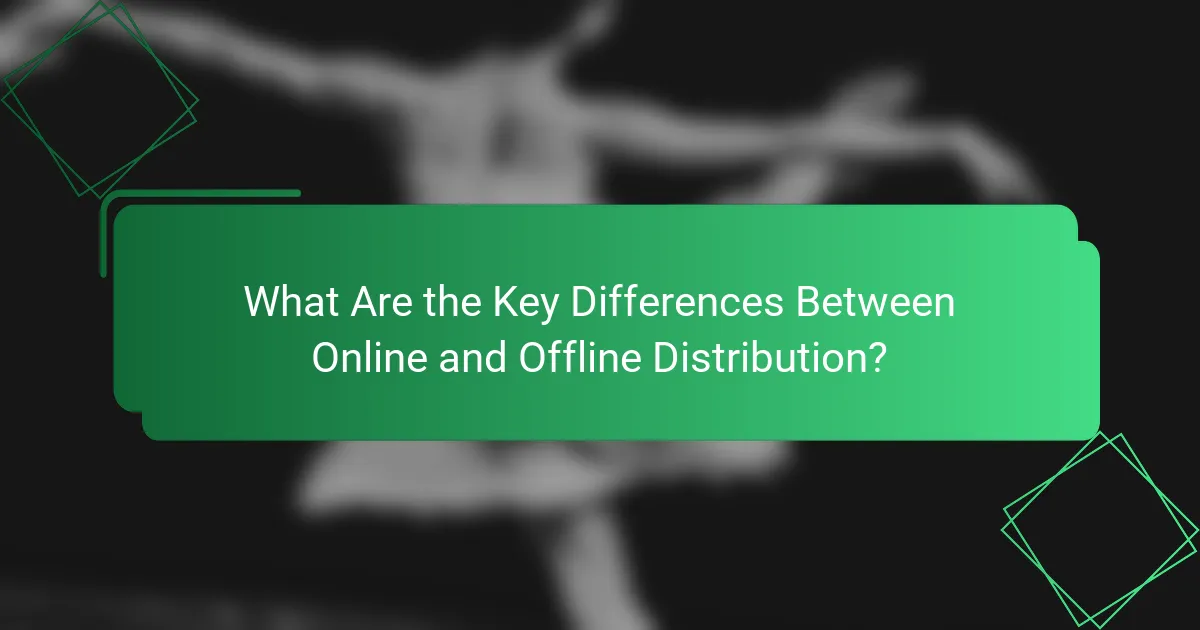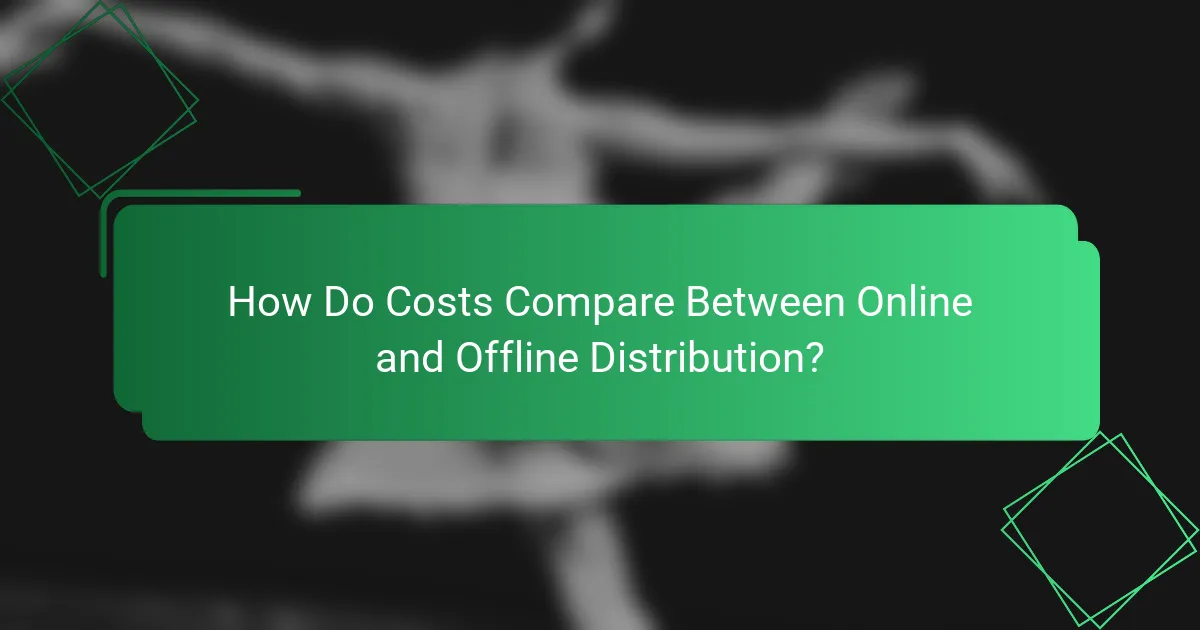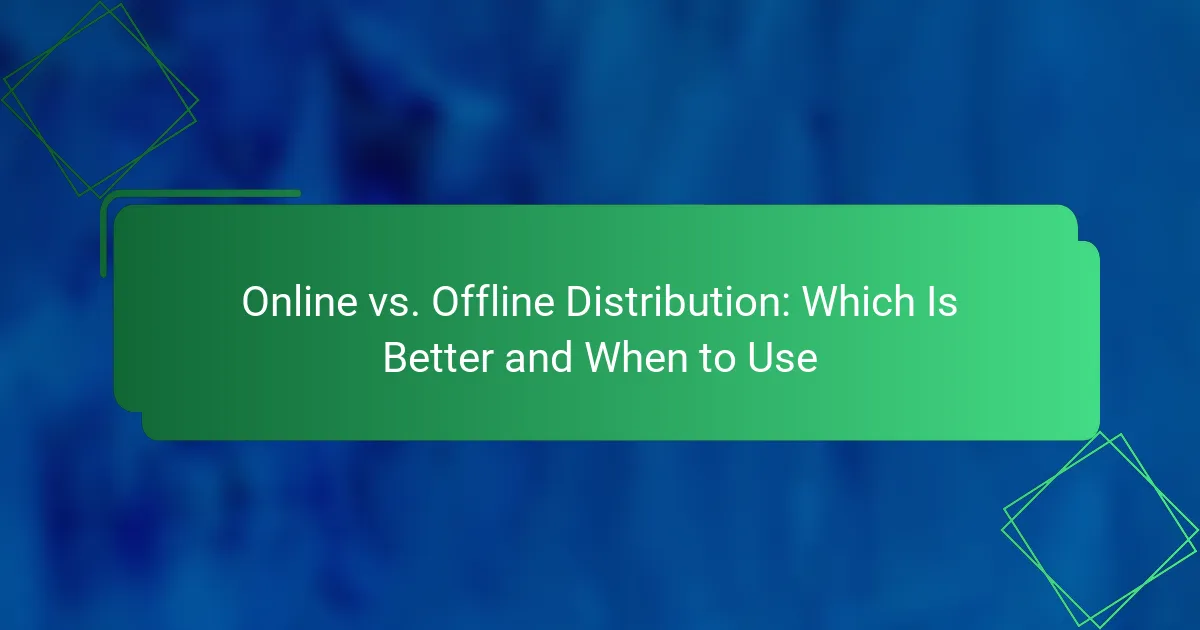In today’s market, businesses must navigate the choice between online and offline distribution methods to effectively reach their target audiences. Online distribution offers rapid access and efficiency, making it suitable for digital products, while offline distribution caters to demographics that value personal engagement and tangible experiences. Understanding when to leverage each approach is essential for maximizing impact and meeting customer needs.

What Are the Key Differences Between Online and Offline Distribution?
Online distribution involves delivering products or services through digital channels, while offline distribution relies on physical locations and traditional methods. Understanding these differences is crucial for businesses to choose the most effective approach based on their target audience and product type.
Definition of online distribution
Online distribution refers to the process of selling products or services via the internet. This includes e-commerce websites, mobile apps, and social media platforms where transactions occur digitally. Businesses can reach a global audience without the limitations of physical storefronts.
Definition of offline distribution
Offline distribution involves selling products through physical retail locations, direct sales, or other non-digital methods. This can include brick-and-mortar stores, trade shows, and face-to-face interactions. It often emphasizes personal customer service and tangible product experiences.
Advantages of online distribution
Online distribution offers several advantages, such as lower overhead costs and the ability to reach a wider audience. Businesses can operate 24/7, providing convenience for customers and potentially increasing sales. Additionally, online platforms allow for easy tracking of customer behavior and preferences.
Another significant benefit is the flexibility in marketing strategies. Companies can quickly adapt their online presence through targeted advertising, SEO, and social media engagement, enhancing their visibility and customer reach.
Advantages of offline distribution
Offline distribution provides the advantage of personal interaction, which can build trust and customer loyalty. Customers often appreciate the ability to see and touch products before purchasing, which can lead to higher conversion rates in certain markets.
Additionally, offline channels can create a strong local presence and community engagement. Businesses can leverage local events and partnerships to enhance brand recognition and customer relationships.
Key metrics for comparison
When comparing online and offline distribution, consider metrics such as customer acquisition cost, conversion rates, and customer lifetime value. Online distribution often boasts lower acquisition costs due to digital marketing efficiencies, while offline methods may yield higher conversion rates through direct engagement.
Other important metrics include inventory turnover rates and return on investment (ROI). Online businesses may experience faster inventory turnover due to broader market access, whereas offline businesses might see higher ROI from local customer loyalty and repeat purchases.

When Should You Use Online Distribution?
Online distribution is ideal when you want to reach a broad audience quickly and efficiently. It is particularly effective for digital products and services, allowing for instant access and lower overhead costs compared to traditional methods.
Best scenarios for online distribution
Online distribution works best for products that can be delivered digitally, such as software, e-books, and music. It is also advantageous for businesses looking to expand their reach without the constraints of physical inventory or geographical limitations.
Consider using online distribution when launching promotional campaigns or seasonal sales, as it enables rapid adjustments and real-time analytics. For instance, e-commerce platforms can quickly adapt to consumer behavior and preferences, maximizing sales opportunities.
Target audience considerations
Understanding your target audience is crucial for effective online distribution. If your audience is tech-savvy and frequently engages with digital content, online channels will likely be more successful. Conversely, if your audience prefers face-to-face interactions or tangible products, consider a hybrid approach.
Demographics also play a role; younger consumers may prefer online shopping, while older generations might lean towards traditional retail. Tailoring your distribution strategy to match the preferences and habits of your audience can significantly enhance engagement and conversion rates.

When Should You Use Offline Distribution?
Offline distribution is best utilized when targeting specific demographics that prefer traditional methods or when products require physical interaction. This approach is effective in scenarios where personal engagement or tangible experiences enhance the customer journey.
Best scenarios for offline distribution
Offline distribution works well in environments where face-to-face interaction is crucial, such as trade shows, local markets, or community events. For example, businesses selling handmade crafts often benefit from setting up booths at local fairs to engage directly with customers.
Additionally, products that require demonstration or sampling, like food items or cosmetics, are more effective when distributed offline. Customers can taste or try products before purchasing, which can significantly influence their buying decisions.
Target audience considerations
Understanding your target audience is essential when deciding on offline distribution. Older demographics may prefer traditional shopping experiences, while younger consumers might lean towards online options. Tailoring your approach based on age, lifestyle, and preferences can enhance effectiveness.
Furthermore, consider geographic factors. In rural areas, offline distribution may be more effective due to limited internet access. Conversely, urban populations may be more receptive to online methods, but offline events can still create valuable local connections.

How Do Costs Compare Between Online and Offline Distribution?
The costs of online and offline distribution vary significantly based on several factors. Online distribution often incurs lower overhead costs, while offline distribution may involve higher logistics and operational expenses.
Cost factors in online distribution
Online distribution generally has lower fixed costs compared to offline methods. Key cost factors include website maintenance, digital marketing, and payment processing fees. For instance, e-commerce platforms may charge transaction fees ranging from 1% to 5% per sale.
Additionally, online distribution allows for broader reach without the need for physical storefronts, which can save on rent and utilities. However, businesses should consider the costs of digital advertising, which can vary widely based on competition and target audience.
Cost factors in offline distribution
Offline distribution typically involves higher costs due to physical logistics, including shipping, warehousing, and retail space. For example, a brick-and-mortar store may face monthly rent that can range from hundreds to thousands of USD, depending on location.
Moreover, offline distribution requires more personnel for sales and customer service, adding to labor costs. Businesses must also account for inventory management and potential markdowns on unsold products, which can further impact profitability.

What Are the Trends in Distribution Channels?
Distribution channels are evolving rapidly, with significant shifts towards both online and offline methods. Understanding these trends helps businesses choose the right approach for their products and target audiences.
Emerging trends in online distribution
Online distribution is increasingly characterized by the rise of e-commerce platforms and social media marketplaces. Businesses are leveraging these channels to reach consumers directly, often utilizing data analytics to tailor their offerings and marketing strategies.
Subscription models and direct-to-consumer (DTC) sales are gaining traction, allowing brands to build loyalty and streamline their supply chains. Companies are also exploring omnichannel strategies, integrating online and offline experiences to enhance customer engagement.
Emerging trends in offline distribution
Offline distribution is seeing a resurgence in experiential retail, where brands create immersive shopping experiences to attract customers. This trend emphasizes the importance of physical presence, with pop-up shops and events becoming popular for brand promotion.
Additionally, local partnerships and community-based initiatives are gaining importance, as businesses seek to connect with consumers on a more personal level. Retailers are also focusing on efficient logistics and inventory management to enhance the in-store experience.

How to Choose the Right Distribution Strategy for Your Business?
Choosing the right distribution strategy involves assessing your business goals, target audience, and product type. Both online and offline distribution have unique advantages, and the best choice often depends on your specific market conditions and customer preferences.
Criteria for selecting distribution channels
When selecting distribution channels, consider factors such as customer accessibility, product nature, and cost-effectiveness. For instance, if your target audience primarily shops online, an e-commerce platform may be more effective than a physical store.
Evaluate the characteristics of your product as well. Perishable goods or items requiring demonstration may benefit from offline channels, while digital products are typically best suited for online distribution. Analyze the costs associated with each channel, including shipping, storage, and marketing expenses.
- Customer Reach: Identify where your customers are most likely to shop.
- Product Type: Match the distribution method to the product’s requirements.
- Cost Considerations: Weigh the expenses of each channel against your budget.
Lastly, consider the competition. If competitors are thriving through a particular channel, it may warrant further investigation to see if it aligns with your business model.
